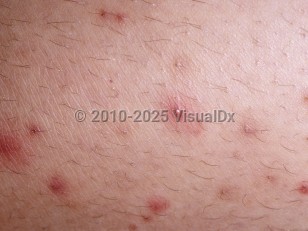Folliculitis in Child
See also in: Anogenital,Hair and ScalpAlerts and Notices
Important News & Links
Synopsis

The etiology of folliculitis can be variable, with bacterial, fungal (eg, pityrosporum folliculitis and candidal folliculitis), viral, (eg, molluscum contagiosum, herpes simplex virus [HSV], varicella zoster virus [VZV]), parasitic (eg, Demodex folliculitis), and noninfectious causes reported. A detailed history of comorbid conditions, exposures, and medications, in conjunction with appropriate ancillary testing, can be helpful.
Specifically in children, bacterial causes such as Staphylococcus are common, as well as yeast, including Pityrosporum. Statistically, children in day care facilities and athletes are at higher risk for community-acquired methicillin-resistant S aureus (MRSA) infection, so suspicion should be high.
Pseudomonal folliculitis has been seen in children following use of a hot tub at a pool party. A similar folliculitis in children who used recreational water facilities has been reported secondary to Aeromonas hydrophila.
Although Demodex folliculitis is very rare in children aged younger than 2 years, one study reported a series of cases in immunocompetent children between 10 months and 5 years of age. It has also been noted in immunosuppressed children with acute lymphoblastic leukemia.
Noninfectious folliculitis may also be considered. Eosinophilic pustular folliculitis of infancy is characterized by pruritic pustules on the scalp and peripheral leukocytosis with eosinophilia. While onset is typically in infancy, cases may last for up to 5 years, and a case of onset in childhood has been reported following bone marrow transplantation in a patient with aplastic anemia.
As expected, children who are immunosuppressed are at increased risk for folliculitis. One study of pediatric dermatology consultations in children with organ transplantations noted that impetigo contagiosum and folliculitis accounted for 6.2% of the cases encountered (see also immunosuppression-associated eosinophilic folliculitis).
Medication-induced folliculitis should also remain on the differential. Medications that can cause folliculitis include corticosteroids, halogens (potassium iodide, radiocontrast media), and lamotrigine.
Codes
L73.9 – Follicular disorder, unspecified
SNOMEDCT:
13600006 – Folliculitis
Look For
Subscription Required
Diagnostic Pearls
Subscription Required
Differential Diagnosis & Pitfalls

Subscription Required
Best Tests
Subscription Required
Management Pearls
Subscription Required
Therapy
Subscription Required
Drug Reaction Data
Subscription Required
References
Subscription Required
Last Updated:06/08/2025
 Patient Information for Folliculitis in Child
Patient Information for Folliculitis in Child- Improve treatment compliance
- Reduce after-hours questions
- Increase patient engagement and satisfaction
- Written in clear, easy-to-understand language. No confusing jargon.
- Available in English and Spanish
- Print out or email directly to your patient


